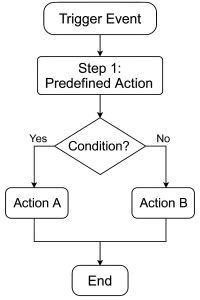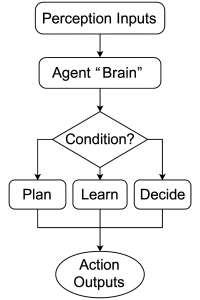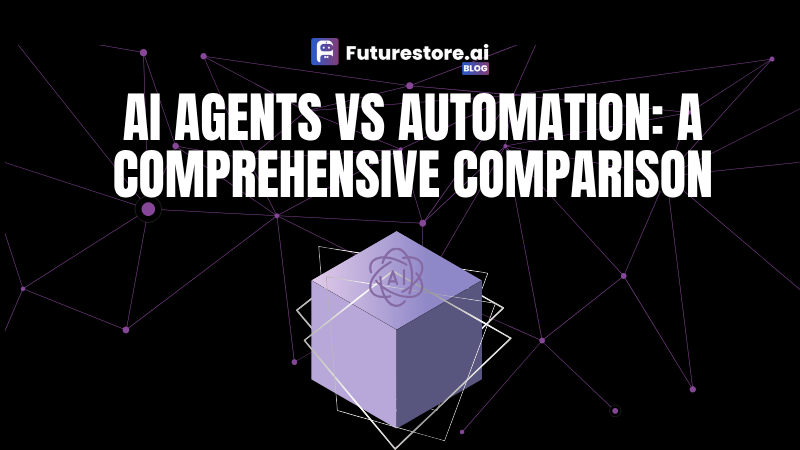In the next few minutes, you’ll get a quick overview and a detailed comparison on AI Agents vs Traditional Automation. This will help you choose which one is best for your business.
Picture a global store that processes thousands of invoices at midnight without any help from people and without any mistakes. When Blue Prism released the first RPA platform in 2001, it started a new era of AI agents that can see, plan, and improve themselves. Businesses today are moving away from fragile, rules-based workflows and toward smart systems that learn from data, deal with uncertainty, and make decisions in real time. As things get more complicated and customers want more, businesses are moving away from static scripts and into the world of context-aware AI agents. This gives them more flexibility, efficiency, and room for growth.
“By 2027, 50% of large organizations will have deployed AI agents in production to automate decision-making tasks,” predicts Gartner.
30-Second Snapshot: AI Agents vs Traditional Automation
- Traditional Automation
- Executes pre-defined, rule-based workflows
- No learning or decision-making beyond coded logic
- AI Agents
- Perceive their environment, learn from data and adapt
- Make context-driven decisions and self-optimize
- Key Differences
- Adaptability: Static rules vs. continuous learning
- Autonomy: Explicit scripting vs. goal-oriented planning
- Decision Making: Hard-coded if/then vs. data-driven inference
- Typical Use Cases
- Traditional: Batch invoicing, scheduled reports, ETL
- AI Agents: Chatbots, recommendation engines, autonomous monitoring
- Why It Matters
- Deploy faster, handle exceptions gracefully and stay ahead of changing demands
Traditional Automation: What Is It? (Examples of Rule-Based Automation)
Conventional automation is centered on workflows that are predetermined and governed by rules. Every step and condition is explicitly coded; no learning or adaptation occurs outside of what has been scripted. The system waits for the next trigger after completing the “if-this-then-that” logic when a trigger fires.
Typical Examples:
Cron Jobs and Scheduled Scripts: Report generation or nightly backups
ETL pipelines: scheduled batch data processing
RPA (Robotic Process Automation): Programs that mimic GUI actions, such as Blue Prism or UiPath
How It Operates:

The Significance of This:
- Predictable Execution: All rules execute precisely as written.
- Easy to Audit: Coded paths are completely traceable, making auditing them simple.
- Low Complexity: Easy maintenance, little data requirements.
- Brittle: Unexpected exceptions break the flow.
- Scalability Limits: Unmanageable rule sprawl occurs.
AI Agents: What Are They? (Advantages of AI Agents)
AI agents are self-governing software systems that, with little assistance from humans, sense their surroundings, make data-driven decisions, and take action to accomplish objectives. Over time, they improve performance, adjust to new situations, and learn from interactions.
Fundamental Technologies:
- Transformers and LLMs: Understanding and producing natural language
- Reinforcement learning: Process of improving behavior through reward.
- Multimedia Perception: Text, vision or sensor fusion.
- Orchestration Frameworks: AutoGPT, LangChain, and other comparable toolkits
How it works:

The Significance of This:
- Context-Aware: Handles uncertainty and insufficient information.
- Self-Optimizing: Constantly gets better with fresh information.
- Scalable Intelligence: Multiple tasks can be performed by a single model.
- Resilient: Able to bounce back from unforeseen events.
Head-to-Head Comparison: AI Agents vs Traditional Automation
| Feature | Traditional Automation | AI Agents |
|---|---|---|
| Adaptability | Static, rule-bound | Continuous learning & model updates |
| Decision Making | Explicit if/then logic | Data-driven inference & probabilistic choice |
| Scalability | Scale via scripts/infrastructure | Scale via data volume & model capacity |
| Error Handling | Fail-stop or coded exception paths | Self-correcting, retry or escalate |
| Use Cases | Batch jobs, scheduled reports, ETL | Chatbots, recommendation engines, monitoring |
A quick lens on which approach fits your operational needs.
Real-World Use Cases: Rule-Based Automation vs. AI Agents
Traditional Automation
- Case 1: Global Bank Invoicing Pipeline
- Challenge: Batch-processing 100K monthly invoices with manual checks
- Solution: Scheduled ETL + RPA form-fills
- Outcome: 50% faster processing, error rate dropped to 2%
- Source: Case Study: Global Bank
- Case 2: Insurance Email Alerts
- Challenge: Policy renewal reminders sent inconsistently
- Solution: Cron-triggered scripts generating and sending templated emails
- Outcome: 30% fewer missed renewals, 20% reduction in customer calls
- Source: CX Case Study for Insurance Providers
AI Agents
- Case 1: E-Commerce Customer Support Chatbot
- Challenge: High volume of repetitive order-status inquiries
- Solution: LLM-based agent integrated with CRM and inventory systems
- Outcome: 70% of queries auto-resolved, 15-point lift in CSAT
- Source: AI-Powered Customer Support Chatbot
- Case 2: Autonomous Warehouse Robot
- Challenge: Inefficient pick-and-pack routes causing delays
- Solution: Reinforcement-learning agent planning dynamic paths
- Outcome: 20% faster fulfillment, 25% lower operational cost
- Source: How AMRs Are Revolutionizing Warehouse Logistics
Pros And Cons: AI Agents and Traditional Automation
| Traditional Automation | AI Agents |
|---|---|
| ✔ Predictable execution | ✔ Context-aware decisions |
| ✔ Clear audit trails | ✔ Self-optimizing behavior |
| ✘ No adaptation | ✘ Requires extensive data & tuning |
| ✘ Rigid rules | ✘ Explainability challenges |
Selecting the Appropriate Tool for Automation Initiatives
Complexity vs. Volume
Low-volume, high-complexity → AI agents
High-volume, low-complexity → traditional automation
Alteration in Frequency
Stable rules → Conventional shines
Changing rules → AI agents adjust
Audit and Regulatory Requirements
Strict adherence → Conventional for transparent trails
Adaptable regulations → AI agents equipped with tools for explainability
Bonus:
- Resources: AI agents require data science expertise, whereas traditional requires fewer ML specialists.
- Cost: Continuous model training versus upfront coding.
- Hybrid: Integrate AI subroutines with rule-based guardrails.
Prospects for the Future: The Development of Cognitive Automation
“In order to balance agility and compliance, forward-thinking organizations will implement hybrid models, enclosing RPA in AI subroutines.” – Jane Doe, UiPath’s CTO.
- Hybrid Architectures: AI agents encased in rule-based frameworks for flexibility and compliance.
- AutoML Agents: They can create and implement new automations on their own with little supervision.
- Explainability and Governance: Integrated toolkits for risk identification, confidence score assignment, and decision tracing.
- Edge-Enabled Agents: On-device processing for privacy and low latency.
- Focus on Ethics and Society: Use human-in-the-loop frameworks to address bias, displacement, and accountability.
- Human-Agent Partnership: Instead of being rule-coders, professionals become overseers, trainers, and curators.
TL;DR + Next Actions:
TL;DR: Static, rule-based scripts are the foundation of traditional automation. AI agents use autonomy and data-driven learning to manage complexity and make real-time adjustments.
Check out : Building AI Agents Without Code: Tools for Non-Developers
Try It Yourself:
- LangChain (open-source AI agent framework): https://github.com/langchain-ai/langchain
- UiPath Community Edition: https://academy.uipath.com/learn/course/automation-fundamentals Resources for a Deep Dive:
- Deloitte’s article “The Rise of Cognitive Automation” can be found at https://www2.deloitte.com/us/en/insights/focus/cognitive-technologies/cognitive-automation.html.
- Microsoft Azure’s “Building Explainable AI Agents”: https://docs.microsoft.com/azure/machine-learning/concept-explainability
Leave a comment with your automation vs. AI-agent use case.

